Leaves in clusters of 5–10, sessile to subsessile; lamina bright green to grey-green, succulent, (2)6–10(14) × 1–3(4) mm, oblanceolate to obovate or narrowly obovate, apex obtuse or rarely acute, glabrous.
Corolla white with white to pale lilac lobes; tube 5–7(9) mm long, narrowly infundibuliform, pilose inside at filament insertions; lobes 2–3 mm long, semi-circular.
Young stems ± unbranched, virtually spineless, dirty-white to light brown, glabrous; older stems ash-grey, with spines up to 15–30(40) mm long.
Stamens unequal, attached 2.5–3(4) mm above the base of the corolla, just below the middle of its tube, 5–6 mm long, just exserted.
Calyx 2.5–3 mm long, glabrous; tube campanulate, 2–3 mm wide; lobes unequal, triangular, acute.
Low or prostrate, intricately branched shrub up to 1 m high and up to 6 m across.
Ovary 2.5 × 2 mm, ± ovoid; style 8–10(11) mm long, exserted.
Flowers hermaphrodite, 5-merous; pedicels 1–5(8) mm long.
Fruit orange-red, 4–5 × 4 mm, ovoid or ovoid-oblong.
Disk golden-yellow, inconspicuous.
Seeds 2 × 1.5 mm, discoid-ovoid.



